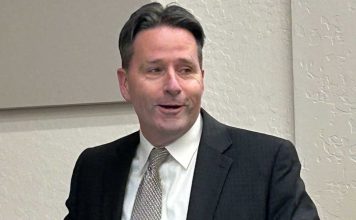Head Coach Rich Hammond whistled and the eyes of 120 football
players were on him. There was too much talk, he said. It was time
to get serious. This was homework time.
Gilroy – Head Coach Rich Hammond whistled and the eyes of 120 football players were on him. There was too much talk, he said. It was time to get serious. This was homework time.
The Gilroy High School football team gathered on the south side of the student center for its second mandatory tutoring session Thursday afternoon. After seeing almost half of the freshman team whittled down because of academic ineligibility last year, athletic department officials instituted thrice-weekly tutoring sessions to raise grades and train better students.
Last year’s loss “really concerned me,” Hammond said. “I don’t think we’re doing our job if that’s the case. We’re doing a disservice to them and we’re doing a huge disservice to our program.”
The football team, in compliance with the state school athletic organization, the California Interscholastic Federation, requires players to maintain a 2.0 grade point average – the equivalent of Cs in all classes. However, when freshmen join the football team in the summer, they do not have any grades to compute an average, so low-achieving students are only discovered and drop out midway through the season when they get their six-week progress report, athletic director Jack Daley said. More students drop out after the season is finished when they get their semester and year-end grades. In 2006, close to 30 of 70 freshmen dropped out of the football program.
“It is a lot of kids,” he said.
The junior varsity and varsity squads lost only a combined three of about 70 players during the season last year. The squads lose few players because students with low averages cannot start the season, Daley said. Winter and spring teams similarly get “self-selected,” high achieving athletes, he added.
Overall, the football team had a 2.51 grade point average last fall – the equivalent of a grade of C+/B- in all classes. This edged out non-athletes, which had a 2.28 average – the equivalent of a C+ in all classes.
The 45-minute study sessions in the student center help students establish a number of habits to achieve academic success, said Hammond, who also teaches math.
“Half the battle is just showing the kids how to use the book,” he said.
Hammond scrambled around the student center for 45 minutes,, checked assignment planners, answered questions in a variety of subjects and taught them study skills. He will also use the school’s new electronic grade-tracking system to track student progress.
The presence of junior varsity and varsity athletes, who have higher collective grade point averages, also exerts a positive influence on the freshmen and builds team bonds, Hammond said.
“If they see the older guys work, it’s a good way to get them to work,” he said. “If we do everything together like this, it makes them more likely to treat each other as equals.”
Freshmen welcome the opportunity to work in a supportive environment.
“I think it helps us out,” ninth-grader Ernesto Rodriguez said. “You’re here and you’re meant to do your work. If you were at home, you might be doing something else.”
Older students sitting across the table expressed willingness to mentor, though they said they have not gotten the chance in the two days so far.
“If they need help, we’ll be more than happy to help them,” said sophomore Chris Louvis, who takes advanced history and math classes.
In hopes of raising freshmen grades, the athletic department also reduced the freshman football schedule from 10 to eight games, pushing the start of the season back two weeks to Sept. 22.
The delay will allow students to “get more connected to school and more focused on school,” Daley said.
While football coaches as tutors might defy stereotypes, it is actually a natural marriage, Hammond said. The tutoring sessions follow the charge of coaches to help athletes succeed academically and athletically.
“We try to make these guys better young men,” he said. “This was a no-brainer.”














